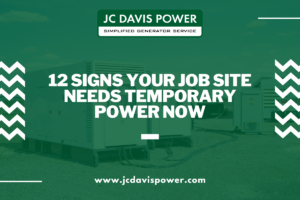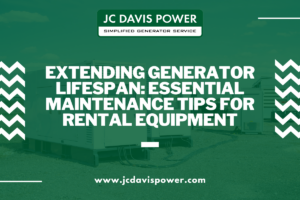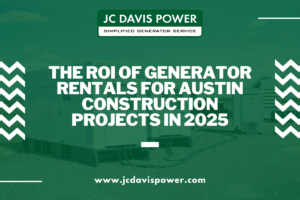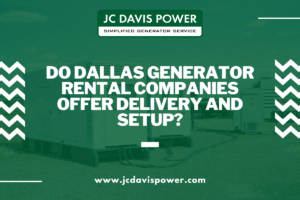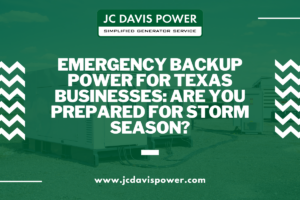Key Takeaways
- Scheduled and predictive generator maintenance reduces downtime and protects rental revenue.
- Strategic maintenance planning, documentation, and staff training keep equipment reliable and customers satisfied.
- Investing in modern predictive maintenance tools future-proofs your fleet and extends generator lifespan.
Ever experienced a project grind to a halt because of a power failure? Frustrating, right? When your rental generator stalls out at a critical moment—at a job site, big event, or during a storm, it’s more than just inconvenient. It can mean lost revenue, delayed deadlines, and some very unhappy customers. That’s why, in an industry hurtling toward a $21 billion global market by 2025 (reservety.com), smart operators know that regular generator maintenance isn’t just good practice. It’s the backbone of business success.
But here’s the game-changer: modern generator care isn’t only about checklists and oil changes. The winning strategy blends traditional scheduled servicing with proactive, predictive maintenance, keeping rental fleets not just running, but running at their very best.
Let’s break down the essentials, complete with actionable steps, industry examples, and a peek at where generator maintenance is headed.
Why Generator Maintenance Matters in the Rental Industry
The Cost of Downtime
Ever wondered what a single poorly maintained generator could cost you? It’s more than spare parts and a day’s rental fee. According to recent analysis, every 10% increase in equipment downtime can slash annual revenue by 7-12% (rentster.eu). For rental businesses and their clients, that’s not small change.
Keeping a reliable rental fleet is about protecting your bottom line and your reputation. Idle equipment means missed deadlines, derailed operations, and unhappy end users—a triple whammy no one wants. (Want to dig deeper? Check out our internal post on Reducing Project Delays with Smart Equipment Management.)
Lifespan and Investment Protection
Think of your generator fleet as an investment portfolio. Every unit you maintain is capital protected. Industry data shows the average age of rental construction equipment is 3-5 years (gitnux.org). The better your generator servicing, the longer these workhorses last—and the steeper your return on investment. One breakdown can undo months of careful planning, so prioritizing prolonged generator life strategies is a must for anyone in the rental world.
Foundational Generator Maintenance Tips for Rental Fleets
Scheduled Inspections & Testing
According to the Uptime Institute, routine generator inspections and testing are crucial for operational reliability (loadbanks.com). Here’s a quick checklist to keep your servicing on point:
| Maintenance Task | How Often? | What to Check |
|---|---|---|
| Oil & Filter Changes | Every 100-200 hours | Oil level/quality, replace filter |
| Cooling System Inspection | Monthly | Radiator, coolant, leaks |
| Battery Testing | Every rental cycle | Connections, wear, and signs of overheating |
| Fuel System & Filters | 21-day intervals | Leaks, sediment, replace filters |
| Electrical & Control Panels | Each return | Connections, wear, signs of overheating |
Pro Tip: Always record your findings in a digital log—details matter, especially for warranty and compliance!
Maintenance Scheduling Best Practices
Did you know the average rental duration for construction equipment is 21 days (gitnux.org)? Sync your maintenance schedule with these cycles to minimize rental interruptions. A quick inspection between rentals can catch issues before the next customer takes delivery.
Need a structured approach? Develop an Effective Equipment Maintenance Calendar to track tasks and automate reminders.
Advanced Approaches: Predictive and Proactive Maintenance
Predictive Maintenance: The Future of Generator Care
Moving beyond routine checkups, predictive maintenance leverages sensors, data analytics, and artificial intelligence to monitor generator health in real-time. The results speak for themselves:
- Reduces breakdowns by 70%
- Increases productivity by 25%
- Lowers maintenance costs by 25%
(llcbuddy.com)
Even better, AI-driven predictive maintenance can extend equipment lifespan by up to 20% (zipdo.co), meaning fewer replacements and more profit from every unit. Imagine catching small failures before they become big, expensive breakdowns—now that’s rental generator care made smart.
What does predictive maintenance look like?
- IoT sensors monitor parameters like temperature, vibration, and runtime.
- Data is analyzed by predictive software (popular platforms include UpKeep and Fiix).
- Alerts are triggered when conditions indicate wear or potential failure.
- Technicians act before breakdown, often with remote diagnostics.
People Also Ask:
What is predictive maintenance for rental generators?
Predictive maintenance uses technology to forecast when equipment needs servicing, increasing reliability and reducing surprise failures.
The Rise in Predictive Maintenance Investment
It’s no wonder the global market for predictive maintenance tech is set to hit $23 billion in 2024 (pmarketresearch.com). Across the industry, forward-thinking rental companies are adopting these solutions to get ahead. Curious about more innovations? Explore our insights on Technology Innovations in Equipment Rental.
Creating an Effective Equipment Maintenance Schedule
Essential Elements of Maintenance Planning
A well-oiled fleet starts with a smart equipment maintenance schedule. Here’s how to build one:
- Inventory Management: Know what you own and where it’s deployed.
- Task Automation Tools: Use platforms like Asset Panda or ServiceMax to plan and record tasks.
- Flexible Scheduling: Build in buffers around peak rental periods.
- Digital Logs: Always keep digital, searchable records (bonus: easier compliance audits).
Budgeting for Maintenance
Industry standards peg maintenance costs at 5-8% of total revenue (finmodelslab.com). While the temptation may be to trim these costs, keep in mind: wise spending here shields you from sky-high repairs and premature equipment replacement.
Strategies for expense control:
- Prioritize maintenance on the most frequently rented equipment.
- Use cost tracking software for real-time expense views.
- Partner with OEMs for volume discounts on parts.
| Cost Management Tactic | Benefit |
|---|---|
| Scheduled bulk servicing | Lower labor/material costs |
| Digital maintenance logs | Ensure warranty compliance |
| Staff skills training | Fewer errors, better checks |
Compliance, Documentation & Staff Training
Proving you’re doing the right thing isn’t just good business—it’s essential for industry compliance. Keep accurate logs, track every service, and regularly train your team to recognize warning signs. For compliance tips, see Best Practices for Equipment Rental Businesses.
People Also Ask:
How often should rental generator maintenance be performed?
Follow manufacturer’s guidelines and inspect between each rental. For heavy use, intervals may shorten.
Proactive Maintenance in Action: Minimizing Risk and Maximizing Uptime
Common Issues Prevented Through Routine Servicing
Letting maintenance slip can open the door for:
- Fuel contamination
- Battery failure
- Overheating
- Corrosion and wiring fault
A strong generator maintenance tips routine is your frontline defense, catching small fixes before they snowball into major failures.
The ROI of Uptime: Keeping Customers Satisfied and Projects Moving
Maintaining high uptime doesn’t just keep machines busy—it delights your customers, builds your reputation, and fuels repeat business. The correlation between satisfied customers and a well-serviced fleet is undeniable.
Industry Trends & Customer Expectations
Aging Rental Fleets & Efficiency
Since the average fleet age is 3-5 years (gitnux.org), ongoing investment in generator servicing becomes even more critical. As fleets age, equipment requires more attentive care to avoid costly breakdowns.
Customer Demand for Reliability and Transparency
Renters expect more than a handshake. They want documented generator service history, real-time communication, and swift response to any hiccup. Offering this builds trust and positions your brand as the go-to for rental generator care in your region.
Helpful tools:
- Service history dashboards
- Customer support chatbots for status updates
- Mobile checklists and reporting apps
People Also Ask:
How can I provide documentation of maintenance to customers?
Digital logs, customer portals, or printed summaries with each rental work wonders.
Wrapping Up: Combining Old-School Wisdom with Smart Tech
Successful generator maintenance is more than a checklist—it’s an ever-evolving strategy. By integrating scheduled care with predictive maintenance, you prolong generator life, safeguard your investment, and win customer loyalty.
Ready to take action? Review your generator fleet’s maintenance program today. Add digital documentation, invest in predictive maintenance tools, and make staff training ongoing—not optional. If you need tailored advice, don’t hesitate to contact us for fleet maintenance consulting or support.
FAQ Section
1. How often should I schedule maintenance for rental generators?
For most rental generators, follow the manufacturer’s recommendations (often every 100-200 hours of use) and always conduct a basic inspection between each rental. High-use periods or harsh conditions may require more frequent checks.
2. What types of generator failures are most common without regular servicing?
Fuel system contamination, battery failures, overheating from clogged cooling systems, and electrical shorts from neglected wiring or moisture intrusion are among the top preventable issues.
3. Which predictive maintenance tools are best for small rental fleets?
Platforms like UpKeep, Fiix, and Asset Panda offer scalable solutions for real-time fleet monitoring, automated reminders, and maintenance recordkeeping—ideal for small to medium businesses.
4. How can I balance maintenance costs without sacrificing equipment reliability?
Prioritize high-usage generators, use task automation to reduce labor hours, and take advantage of bulk parts/service discounts from trusted suppliers. Maintenance typically runs 5-8% of revenue—a solid guideline for budgeting.
5. Why do customers care about a documented maintenance history?
Transparency builds trust. It reassures renters that equipment is reliable, well-cared-for, and safe to operate—key factors for winning repeat business and positive reviews.
